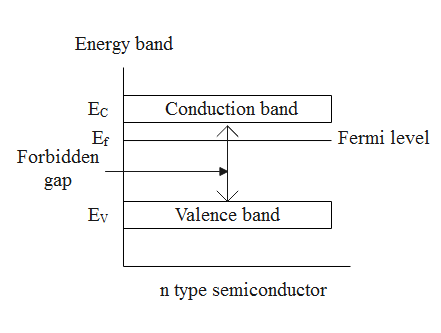
In an n-type semiconductor, the Fermi level is present:
A. just below the valence band
B. just below the conduction band
C. just above the valence band
D. in the middle of valence and conduction bands
Answer
539.4k+ views
Hint: This is a theoretical question based on the concept of the extrinsic semiconductors. Firstly, we will discuss the n-type semiconductor. Then, we will continue with its properties, and finally with the study of the Fermi level.
Complete answer:
An n-type semiconductor is a category of an extrinsic semiconductor. In the case of n-type semiconductors, the electron donor atoms play an important role, as these types of semiconductors are doped with the electron donor atoms.
The donor atoms contribute the free electrons to the semiconductors, thus, the n-type semiconductors have free electrons in plenty when compared to the holes. Basically, the pentavalent atoms are introduced into the semiconductors. Here, the pentavalent atoms refer to the atoms having 5 valence electrons.
The energy level diagram of an n-type semiconductor :

The terms used in the diagram are defined as follows.
Conduction band – an energy band filled with the free electrons.
Valence band – an energy band filled with the holes.
The forbidden gap – the gap between the conduction and the valence band.
Fermi level – the highest energy level that an electron can occupy at absolute 0 temperature.
From the energy level diagram of the n-type semiconductor, it’s clear that the Fermi level is present near the conduction band and far away from the valence band.
In the case of n-type semiconductor, the Fermi level is present just below the conduction band.
As the Fermi level is present just below the conduction band in the case of n-type semiconductor, thus, the option (B) is correct.
Note:
The pentavalent impurity atoms (atoms that provide extra electrons) introduced into the semiconductors are antimony, phosphorous, arsenic, etc. These impurity atoms are added to the pure germanium or silicon semiconductors to make them n-type semiconductors. Therefore, in n-type semiconductors, the electrons are called the majority charge carriers and the holes are called the minority charge carriers.
Complete answer:
An n-type semiconductor is a category of an extrinsic semiconductor. In the case of n-type semiconductors, the electron donor atoms play an important role, as these types of semiconductors are doped with the electron donor atoms.
The donor atoms contribute the free electrons to the semiconductors, thus, the n-type semiconductors have free electrons in plenty when compared to the holes. Basically, the pentavalent atoms are introduced into the semiconductors. Here, the pentavalent atoms refer to the atoms having 5 valence electrons.
The energy level diagram of an n-type semiconductor :

The terms used in the diagram are defined as follows.
Conduction band – an energy band filled with the free electrons.
Valence band – an energy band filled with the holes.
The forbidden gap – the gap between the conduction and the valence band.
Fermi level – the highest energy level that an electron can occupy at absolute 0 temperature.
From the energy level diagram of the n-type semiconductor, it’s clear that the Fermi level is present near the conduction band and far away from the valence band.
In the case of n-type semiconductor, the Fermi level is present just below the conduction band.
As the Fermi level is present just below the conduction band in the case of n-type semiconductor, thus, the option (B) is correct.
Note:
The pentavalent impurity atoms (atoms that provide extra electrons) introduced into the semiconductors are antimony, phosphorous, arsenic, etc. These impurity atoms are added to the pure germanium or silicon semiconductors to make them n-type semiconductors. Therefore, in n-type semiconductors, the electrons are called the majority charge carriers and the holes are called the minority charge carriers.
Recently Updated Pages
Class 12 Question and Answer - Your Ultimate Solutions Guide

Define current sensitivity and voltage sensitivity class 12 physics CBSE

Draw the molecular orbital energy level diagram of class 12 chemistry CBSE

Predict the direction of induced current in metal rings class 12 physics CBSE

A star appears slightly higher above then its actual class 12 physics CBSE

Why did political leaders differ sharply over the question class 12 social science CBSE

Trending doubts
Which are the Top 10 Largest Countries of the World?

What are the major means of transport Explain each class 12 social science CBSE

Draw a labelled sketch of the human eye class 12 physics CBSE

How much time does it take to bleed after eating p class 12 biology CBSE

What is the Full Form of PVC, PET, HDPE, LDPE, PP and PS ?

Draw ray diagrams each showing i myopic eye and ii class 12 physics CBSE




